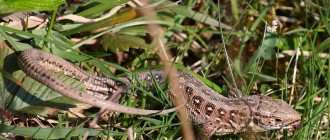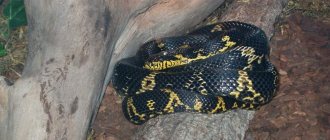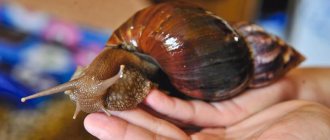Arachnophobia is the most common phobia in the world. Indeed, for many people, spiders are a complete nightmare.
The goliath tarantula is considered one of the most terrible species of arthropods. After all, its size is comparable to the parameters of a human face.
Theraphosa blond is the largest spider in the world. However, there is no point in being afraid of the goliath tarantula. This type of arachnid almost never attacks humans.
It feeds primarily on mice, snakes and small birds. But the spider bites people and large animals only for the purpose of protection.
Description of the Goliath tarantula
The largest mygalomorphic spider, Theraphosa blondi, belongs to the large family Theraphosidae (from the suborder Orthognatha), which includes approximately 800 species.
The term “tarantula spiders” appeared thanks to Maria Sibylla Merian, a German animal painter who depicted the attack of a huge spider on a hummingbird in a series of her engravings. Her work "Metamorphosis insectorum Surinamensium" with drawings of an arachnid monster was presented to the public in 1705, but only a century later (in 1804) Theraphosa blondi received a scientific description from the French entomologist Pierre André Latreille.
Appearance
Like other spiders, the body of the goliath tarantula consists of two sections connected by a special tube - the cephalothorax and a complete abdomen. About 20–30% of the volume of the cephalothorax is in the brain. The dorsal shield of the Goliath spider has equal width and length.
The cephalothorax is divided by a groove into two parts, the head and chest, the first being equipped with 2 pairs of limbs. These are chelicerae, consisting of a single thickened segment with a movable claw (under the tip of which there is a hole for removing poison) and a pedipalp, divided into 6 segments.
The mouth, adapted for sucking out soft contents, is located at the top of the tubercle between the chelicerae. Four pairs of legs, each of which is composed of 7 segments, are attached directly to the cephalothorax, behind the pedipalps. The goliath tarantula is discreetly colored, in different shades of brown or gray, but light stripes are noticeable on the legs, separating one segment from the other.
Interesting. Theraphosa blondi is shaggy - long hairs cover not only the limbs, but also the abdomen, the stinging hairs of which are used for protection. The spider scratches them with its hind leg towards the enemy.
The hairs act like tear gas, causing itching, stinging in the eyes, swelling and general weakness. Small animals (rodents) often die, large ones retreat. In humans, hairs can cause allergies, as well as blurred vision if they get into the eyes.
In addition, the hairs, which detect the smallest vibrations in the air/soil, replace the spider (deprived of ears from birth) with the organs of hearing, touch and taste. The spider does not know how to recognize taste with its mouth - the sensitive hairs on its legs “report” on the edibility of the victim. Hairs also become a useful material when weaving webs in a nest.
Goliath spider dimensions
It is believed that an adult male grows up to 4–8.5 cm (excluding limbs), and a female – up to 7–10.4 cm. Chelicerae grow on average to 1.5–2 cm. The leg span in rare cases reaches 30 cm, but more often does not exceed 15–20 cm. Record figures for dimensions belong to females of Theraphosa blondi, whose weight often reaches 150–170 g. It was this specimen with a paw span of 28 cm, caught in Venezuela (1965) that was included in the Guinness Book of Records.
Lifestyle, behavior
Each goliath tarantula has a personal area, the area of which is several meters from the shelter. Spiders do not like to leave the lair far and long, so they try to hunt nearby in order to quickly drag their prey into the house.
Other people's deep burrows often serve as refuge, the owners of which (small rodents) die in fights with goliath spiders, at the same time freeing up living space for them.
The spider covers the entrance to the hole with a web, at the same time tightly enveloping the walls with it. He doesn't really need light, since he doesn't see very well. Females sit in the den for most of the day, leaving it during night hunting or during the breeding season.
When dealing with living creatures, tarantula spiders use poisonous chelicerae (which, by the way, can easily pierce a human palm). Chelicerae are also involved when notifying the enemy of a planned attack: the spider rubs them against each other, producing a distinct hissing sound.
Appearance, color and size
Tarantula spiders are a family of arachnids called Theraphosidae (the so-called “true tarantulas”), the members of which are so named because of the nuances of the “first encounter”.
At the end of the 18th century, one of these spiders was spotted eating a hummingbird in a Venezuelan forest, and since then it has long been believed that they feed exclusively on birds. Well, “goliath” is an unofficial but widespread name for tarantula spiders of the species Theraphosa blondi.
Familiarize yourself with the types of spiders.
Representatives of this species are considered the largest spiders on the planet, for which they were named after the famous biblical character, famous for his height and strength.
The average body size of a goliath is about 10 cm, but together with its thick hairy legs, the arthropod can reach 28 cm. Female individuals are traditionally larger than their “men” and seem much more massive than them.
Body color varies from light brown to reddish brown. The spider's body itself is represented by a connected cephalothorax and abdomen, covered with a dense chitinous exoskeleton.
It serves as reliable protection against various injuries and retains moisture in the body, which is especially important for species living in arid zones. The head and chest of the tarantula are protected by a shield-frame, and on its front part there are eyes (by the way, the arthropod has 4 pairs of them).
The organs of the digestive tract and reproductive system are located in the abdominal part, at the end of which there are arachnoid appendages (2–6 pairs).
Did you know? The largest tarantula spider found is considered to be Theraphosa blondi, whose limb span reached 28 cm (it was found in the 60s of the last century).
However, he is not the only record holder in terms of size. Its competitor is a spider from the species Heteropoda maxima, which has a large limb span (up to 35 cm) but a smaller body.
Goliath, like other spiders, has 6 pairs of limbs, of which 4 pairs are used for movement, and two (chelicerae and pedipalps) are used for digging holes and capturing prey; they are located in the front and have small poisonous glands. All limbs are covered with hard hair.
Video: about goliath spiders
Nutrition
The Goliath tarantula spider owes its name to the German entomologist Maria Merian. While traveling through the countries of South America, she saw a picture of a huge spider eating a hummingbird. The information immediately hit the press, and that’s how the name was attached.
The main diet of the Goliath spider:
- insects;
- snakes;
- snakes;
- beetles;
- small birds, chicks;
- snakes;
- frogs;
- toads;
- rodents;
- small arachnids.
The predator does not build trapping nets, does not weave webs, and prefers active hunting. Moves around the area, stalks prey. At the right moment, it instantly attacks, bites with long fangs, injects poison and its own saliva. The first substance paralyzes the victim, the second liquefies the insides. The Goliath spider waits on the sidelines for some time; when the victim’s convulsions stop, he begins to eat.
Goliath spider feeding
Hunts in the dark, sits in a secluded place during the day. This behavior is associated with the presence of a large number of natural enemies - the cat and dog family. Defending itself from an attacker, the goliath tarantula turns its back to him and quickly sheds thin, spiky hairs containing poison. While the predator comes to its senses, the spider crawls away.
Interesting!
The arthropod is capable of regenerating a damaged limb. Initially, it discharges the residues, then directs liquid there, which over time turns into a solid formation. The process is long, but eventually a new leg is formed. Throughout her life, the female molts 5-7 times. In this way, she sheds parasites, increases in size, and renews her poisonous coat.
Lifestyle
The Goliath tarantula spider lives in humid, warm countries in swamps. This is the South of America, namely Brazil, Suriname, Guyana, Venezuela.
Theraphosa blond often settles in empty rodent burrows. Sometimes the spider digs out its own shelter.
The goliath tarantula does not like the sun. For normal existence, arachnids need darkness and high humidity. A temperature of about 25-30 °C is suitable for arthropods.
When the rainy season arrives, the goliath makes itself a shelter on an elevated plain. Theraphosa blond's home is a deep burrow, shrouded in cobwebs at the entrance.
As the name suggests, the goliath tarantula must eat birds. But this is a misconception; birds are not the spider’s favorite food. At the same time, Theraphosa blond does not intentionally hunt birds. But the spider can take advantage of the situation and eat the chick that has fallen out of the nest.
Goliath tarantula's hunting method:
- the spider waits for prey, hiding in a secluded place.
- When the prey is nearby, the goliath instantly attacks it and bites it to paralyze it with a neurotoxin.
The tarantula has another means of hunting, protecting itself or obtaining food. These are fangs, up to 2 cm long. The spider can easily pierce human skin with its poisonous teeth.
Like other tarantulas, tarantulas have poor eyesight. To hunt, arachnoids use vibrations coming from the ground. Sensing the trembling, the spiders determine the location of the victim and attack it.
Before attacking large prey, the goliath hisses loudly. Sound production is achieved through friction of the jaws.
When the female is ready to mate, she secretes special substances that attract males. The latter fight fiercely with each other to get the female. But the spider chooses her partner very carefully.
Females of the blond theraphosis are very caring towards their offspring. During fusion, the male supports the female's large chelicerae with his forepaws to protect himself. After mating, the males immediately run away to avoid being eaten by the spider.
After mating, females weave a small cocoon, necessary for future egg laying. At the same time, a spider can bear up to 200 eggs.
The period of egg development is 6-7 weeks. During this time, the female constantly looks after her offspring, taking the cocoon with her even when hunting.
During this period, the spider is especially aggressive. She may attack a large animal or person if she feels threatened. After hatching, the spiders do not leave their burrow until the first molt.
Tarantulas can molt and shed their skin. This is how they grow new legs to replace damaged limbs.
The molting process lasts 2-5 hours. The arachnoid increases fluid pressure in the body and sheds the dead paw. Then he pumps in new fluid to build up the limb.
Interestingly, residents of South America consider tarantulas a delicacy. For this reason, the Theraphosa blond population is constantly declining.
Reproduction
Arthropods reproduce throughout the year. Sometimes it is interesting to observe the behavior of spiders. The male gracefully taps his paws in front of the female's home to attract attention. If the female is ready for mating, she allows her partner to approach her.
After some time, the female constructs a cocoon in her hole, in which she lays up to a hundred eggs. Scientists noticed one interesting fact. The babies hatch after ten weeks and immediately after birth they scatter in different directions.
The dimensions of small spiders reach 20 centimeters in length. The males die soon after fertilization.
Behavior and treatment
Goliaths are very aggressive spiders and are best kept alone. They are fast and nervous. When threatened, they rub the stubble on their legs, making a hissing, fairly audible sound. Spiders rub their hairs to shake them towards the enemy. They can rear up and raise the hair on their belly. They may try to bite.
Under no circumstances should you touch the goliaths - they will defend themselves. The spider's barbed, venomous hairs can cause severe irritation, and the bite can be extremely painful and dangerous due to the size of the fang (almost 2.5 cm).
Use a paint brush or other objects to shoo the goliath away while you clean up or to force it into a container to move.
External links [edit]
| Wikimedia Commons has media related to Theraphosa blondi . |
| Wikispecies has information about Theraphosa blondi . |
- Caring for Your Goliath Bird Eating a Tarantula at the Wayback Machine (archived October 31, 2013)
- Video of the Goliath tarantula at National Geographic
| Taxon identifiers |
|
| Authoritative control |
|
Goliath Spider Venom
Despite the fact that the spider has large fangs that easily bite through human skin, its venom is not dangerous to humans if there are no allergic reactions. The effect of the poison on humans is similar to that of a bee or wasp. A spider can bite a person only in self-defense, and in most cases the bite will be dry, without poison.
Spider hairs have an irritating effect; if they come into contact with the skin, they cause an itching effect; if they get into the respiratory system or mucous membrane, they can cause an allergic and irritating reaction.
If a spider releases venom during a bite, the following symptoms may appear: nausea, pain, redness and swelling may appear at the site of the bite.
All symptoms disappear within a few days. No fatalities from a spider bite of this species have been recorded.
One of the largest species of spiders. Royal baboon spider.
In 1899, the royal baboon spider (Citharischius crawshayi) was discovered in East Africa. At that time it was the largest of all known African spiders. Its length reaches 15 centimeters, and its leg span reaches 20 centimeters. It prefers pastures and forests as its habitat. Royal baboon spiders construct huge burrows that protect them from predators and overheating in the strong sun. The length of such a hole can reach from 60 centimeters to 2 meters.
They feed on insects, small invertebrates, lizards and frogs. Royal baboon spiders easily catch animals that are larger than them. Birds nesting on the ground are their favorite food.
The Royal Baboon Spider is known for its irritable nature. If he gets angry or scared, he rises on his hind legs and shows his poisonous teeth.
The lifespan of a female is about thirty years. Males live much shorter lives - on average about ten years.
The royal baboon spider has a beautiful orange-brown color. It grows very large, and novice spider lovers often keep it as a pet.
However, it is believed that getting a royal baboon spider as your first spider is not a good idea. Royal baboon spiders are famous for their aggressiveness and are ready to use their large fangs at any moment. When provoked, they may make a threatening hissing sound, but may not do so.
Moving very quickly, the King Baboon Spider can attack without warning.
Its venom is stronger than that of most other spiders and can cause serious trouble. Although no one has yet died from its bite, the bite still causes severe pain. Swelling may form at the site of the bite. Spasms and muscle cramps are possible. If you are bitten, it is recommended to visit a doctor.
Royal baboon spiders have a highly developed tendency to escape. Despite their large size, they can squeeze into tiny holes. They are very strong and can easily remove the lid from the terrarium if it is not securely secured. Royal baboon spiders are able to manipulate any latches and fasteners within their reach.
They are very popular because they can live even in small terrariums, but when the king baboon spider grows up, a small terrarium will constantly provoke it to escape. Since these spiders belong to the burrowing type, a thick layer of substrate is also required in the terrarium: at least ten centimeters. In addition, in a confined space it will be difficult to feed.
The king baboon spider in captivity eats the same types of live prey as other spiders. These are crickets, earthworms, cockroaches, which can easily be bought at a pet store. But there is one problem: it is difficult to determine the amount of food a spider needs. A spider this large is expected to eat a lot. The royal baboon spider carries live prey into its burrow to eat it. We cannot find out whether he ate his food or whether the food was left to rot in the hole, since getting food out of the hole is problematic. Therefore, novice spider lovers often overfeed their pets. In addition, the size of the prey offered to the spider should be half the size of the spider itself. Larger amounts of live food may cause damage to your pet.
.
So make sure you understand what type of spider you are getting. Will you be able to take good care of him and will this exotic pet not disappoint you!
Source
Food and hunting
Goliath spiders practice secretive hunting. He sits inside his hole and, thanks to his hairs, detects any movements around him.
At the right moment, he suddenly jumps out of the hole and attacks his prey. Like all spiders, he injects his poison into it, which kills the victim and dissolves its insides, and then sucks them out of it.
The spider's diet consists of various insects, other arthropods, worms and small vertebrates.
Goliath spider eats a mouse
It can easily catch and eat amphibians, rodents, lizards and some snakes. Sometimes it can catch a bird, but this happens quite rarely.
What does it eat in the wild?
The goliath spider eats other arachnids and insects.
Also present in the diet of arthropods are:
- chicks;
- lizards;
- rodents;
- crickets;
- frogs;
- zoophobes;
- spiders;
- mealworms.
Next to their own burrow, arachnoids stretch a signal web. If prey steps on the thread, the tarantula gets out of the home and pounces on it.
Next, the goliath injects poison into the victim, dissolving its insides. The tarantula does not eat bone tissue, skin or chitinous shell.
Theraphosa blondi can survive for 2-3 months without food. Moreover, hunger does not have a negative impact on his health.
Danger to humans
The goliath tarantula is not distinguished by aggressive behavior, it does not rush to attack at the sight of a person, but it betrays its unfriendly attitude by hissing. The bite is inflicted solely for the purpose of self-defense. In terms of the strength of the painful sensations, it is compared to a wasp or hornet. A spider bite is not life-threatening, but causes some discomfort.
Redness, swelling, and pain appear at the site of the bite. In young children, people with weak immunity, and allergy sufferers, there is a deterioration in general health - dizziness, weakness, headache, nausea, vomiting, fever. The condition returns to normal after a few days; antihistamines are taken to speed up the therapeutic effect.
Natural enemies
Theraphosa blondi, despite its inherent toxicity, has quite a few of them. Large predators are not particularly interested in the goliath, but he and his offspring often become the gastronomic target of the following hunters:
- centipedes, for example, Scolopendra gigantea (40 cm in length);
- scorpions from the genera Liocheles, Hemilychas, Isometrus, Lychas, Urodacus (partially) and Isometroides;
- large spiders of the genus Lycosidae;
- ants;
- aha toad, or Bufo marinus.
The latter, by the way, has adapted to climb into holes where females and children are located in order to methodically devour newborns.
Goliath tarantulas also die under the hooves of heavy collared peccaries.
The largest tarantula spider
In 1965, the largest representative of the species was recorded. Its size with straightened legs reached more than 28 cm. It was discovered in Venezuela.
However, in 2001, a new species was discovered, the paw span of which reached 30 cm. But at the same time, the new species Heteropoda maxima has a smaller body size.
Its size helps it cope with many small animals: rodents, frogs, toads, birds, lizards and snakes.
Tarantulas are not only the largest, but also the longest-lived among terrestrial arthropods. Although this cannot be said about males, who die immediately upon reaching sexual maturity, they live no more than a year. It is possible that a hungry female may attack and eat the male immediately after mating. But females can live for many years. There have been cases where a female tarantula lived to be 30 years old. The older the spider, the larger the size it can reach.
The age of tarantulas is most often measured in molts. While shedding the old exoskeleton, the size of the spider can become one and a half times larger. At the beginning of life, he can shed every month; in adulthood, the interval increases. And adult females change their exoskeleton about once a year.
After molting, the spider increases in size, lost protective hairs are restored on the abdomen, and the color becomes lighter.
Range, habitats and lifestyle
The Goliath spider is native to South America. It is found in Brazil, Venezuela, Guyana, preferring warm and humid regions with marshy areas and ample food.
Tarantulas settle in forest thickets, digging themselves small holes in the ground, under the roots of trees, and strengthening them with cobwebs. With age, the lifestyle of these spiders may change, but not significantly: emerging from eggs in burrows, they remain there for almost their entire lives.
Did you know? The most terrible enemy of the tarantula spider in the wild is the wasp spider, which is 6–7 times smaller than its prey (with straightened legs its dimensions do not exceed 4 cm). This arthropod is safe for humans, but it can kill a goliath in a few minutes.
Goliaths lead a sedentary lifestyle (this is a common characteristic for all varieties of tarantulas): well-fed individuals can remain in their shelter for several months. You can identify a goliath spider's hole by its entrance, which is densely covered with cobwebs.
Conditions of detention
This breed is not suitable for novice breeders. Before purchasing a pet, you need to familiarize yourself with its features, advantages and disadvantages of keeping it. On the Internet you can very easily find a description of the insect breed you are interested in.
Goliaths are considered aggressive from birth. That is why a beginner should not take risks. Experienced collectors will not mind adding an interesting specimen to their collection. For a comfortable stay at home, the tarantula will need:
- spacious terrarium. Each enclosure contains only one individual;
- litter up to 10 cm high. The soil can be a mixture of sand and soil or coconut shavings;
- fresh water must be constantly available to the insect;
- lighting can be provided by moonlight lamps;
- Daytime temperatures vary from 24 to 28 degrees. At night - up to 22. At the same time, air humidity is 90 percent;
- Every day the soil is sprayed with warm water. It is very important to prevent overwatering;
- young individuals feed two to three times a week, while adults only need one.
The lifespan of the Goliath tarantula spider depends on gender. Females live a long, happy life - 20 years, males - 4 years.
Overall, the goliath is an unusual exotic insect. To most people, tarantulas seem like scary creatures. However, there are also those who are delighted with arthropods and have their own collections at home.
Many people are interested in how much a spider costs and where in Moscow they can buy it? Experts recommend purchasing insects from professional breeders. The price depends on the size and age of the individual.
Video
Spiders are long-lived
Common house spider
The lifespan of house spiders is usually 8-12 months. They die after breeding, from lack of food, by human hands.
Only 10 species of spiders out of 42 thousand can live in houses and apartments. The most common species is Tegenaria domestica. This is a small (12 mm in diameter including legs) spider of a yellowish-brown color.
It weaves a flat triangular web, not just one, but several at once, and connects them with threads for movement. Under favorable conditions it can live up to 5 years. It is harmless and non-aggressive, but can bite a person if pressed down.
In private homes, a cross is often found. It is distinguished by a white cross on the back and a patterned circular web. The life span of the cross is short: males can live from 4 to 6 months, females - 2-3 months.
Sometimes you come across a haymaker (“long-legged”) - a small oblong body from 2 to 10 mm long on long, fragile legs. The web is woven chaotically and has no clear shape. This spider lives at home for about 2 years.
Exotic animals
Large poisonous spiders have long gained popularity as exotic animals suitable for home keeping. Even at home, it is quite possible to create favorable conditions for their existence and reproduction.
Tarantulas or tarantulas are usually kept in the apartment. There are many varieties, differing in color, behavior, hairiness and body structure. They can live for a long time, so some people become attached to such pets in the same way as to cats or dogs.
Popular types of tarantulas:
- curly-haired (Brachypelma Albopilosum) – black, covered with pinkish hairs. The most unpretentious look. The bite is noticeable, painful, but not dangerous to human health. Males live 3 to 4 years, females can live more than 20 years;
- woody (Avicularia Versicolor) – covering of young growth is blue with white hairs. The adult individual is colored in blue, red, green shades with a metallic tint. One of its features is that it moves very quickly. The poison is safe for humans. Males live from 1.5 to 2 years, females can live up to 8 years;
- The Horse Spider (Lasiodora Parahybana) is one of the largest tarantulas. The color is gray with black or brown. Actively digs the substrate and easily chews through fragile parts of the terrarium. Females can live 15-25 years, males - from 2 to 3 years.
For terrarium maintenance, 5 types are usually used:
- Apulian is one of the largest (body length up to 7 cm long). Females are red in color and their lifespan ranges from 3 to 4 years. Males are light gray and can live no more than 2-3 years.
- South Russian (also called “mizgir”). Body length 3.5 cm. Color varies from brownish to brown. Can live up to 5 years.
- Spanish. The male is dark gray. Lives for about 2 years, participates in fertilization only once in its life. Females are red in color with a striped belly. They can live more than 5 years.
- Mexican. Fluffy, abdomen length up to 14 cm, black-gray color, the folds of the legs are red (the second name of the spider is “red-knee tarantula”). They are distinguished by their slow growth and maturation: males are capable of fertilization at the age of 4 years, rarely live longer than 10, females can give birth to offspring at 6-7 years, and live up to 20-30 years. In captivity, maturation occurs faster, which reduces life expectancy.
- Brazilian black. The abdomen is 7 cm long, the body is black and shiny. Relatively calm view. They mature at the age of 6-7 years, females can live 20 years. Males rarely reach 10.
To increase the lifespan of a spider, it needs to be fed less (the rule does not apply to juveniles). The abundance of food provokes growth and change of the exoskeleton.
The more often this animal sheds, the shorter it will live. Tarantulas can refuse to eat for about 2 years for no apparent reason. They are considered the longest-livers among their relatives.
It’s not worth doing such experiments on them at home, but if he doesn’t want to eat for 1-2 weeks, then there’s no need to persistently feed him. Such a hunger strike will not affect the quality of life. This usually happens before molting.
Mice, lizards and frogs should not be given. This means an increased risk of injury to the spider and an unpleasant odor in the house. The best option is marble cockroaches.
At cool temperatures, the metabolic processes of the spider's body slow down, which also helps to increase its lifespan. In the wild, hibernating spiders will live longer than indoor spiders.
To prolong the life of a male spider during the mating process, it is important to monitor the behavior of the female. It is necessary to intervene in time with the help of special forceps or a shield, since spiders usually eat their partner after fertilization. At the end of the process, the couple is separated
Once the process is complete, the couple is separated.
Poisonous or not
All varieties of tarantula spiders are poisonous in their own way, and if we are talking about a non-poisonous representative, then most likely we mean the low toxicity of its poison. A bite from this arthropod cannot cause much harm to an adult and healthy person, but small pets can die. In addition, goliath is considered dangerous for small children and people suffering from allergic reactions to the toxin released with the poison.
Important! Not in all cases, when a spider bites, poison is released, but it is stored on the arthropod’s legs, which is why any contact with it must be done with gloves. Allergies usually result in severe itching, burning and general weakness.
Choosing and arranging a home
The first thing you should consider before buying a goliath is arranging a separate home for it, and if you plan to have a pair, then there should be two terrariums.
Video: setting up a terrarium for a tarantula spider
Tarantula spiders should not be kept in groups as they are aggressive towards each other. The lifespan of females is longer, but males have brighter colors, due to which they are chosen more often.
Whatever gender you prefer, the requirements for the terrarium remain the same:
- it must be made of durable plexiglass;
- the dimensions of the tank should be several times greater than the parameters of its inhabitant (including the legs), and it is better that these are cube-shaped containers: for example, 20x20x20 or 30x30x30 cm;
- the lid of the terrarium must have ventilation holes with a diameter of 2–3 mm and adhere well to the tank (so that the spider cannot escape);
- When making your own, it is advisable to use silicone sealant.
It is worth paying attention to the arrangement of the internal space of the tank. If you are going to purchase terrestrial inhabitants that settle in burrows, you will have to pour a 15-centimeter layer of soil into the terrarium, which will provide the spider with conditions as close as possible to natural ones.
You can cover the bottom with less soil, but then you will have to place additional objects in the terrarium to serve as shelter for the goliath. These could be parts of a pot for a flowerpot, fancy driftwood, or special decorative elements purchased at a pet store. Coconut filler (crushed coconut bark), which is sold in the same pet store, is ideal for the role of substrate.
The necessary conditions
The tarantula spider is a tropical resident, which means that at home it needs to create appropriate conditions that are as close as possible to its natural habitat.
Important! If possible, it is worth purchasing a special device from a hardware store that will measure the temperature and humidity in the tank with the spider. This way you can timely adjust the indicators to the required values.
Taking this into account, we need to focus on the following indicators:
- air humidity in the terrarium is 75–90% (if necessary, you can wet the inner walls of the tank with a spray bottle, be sure to install drinkers with a large area inside; reduced air humidity causes problems with molting);
- temperature - the ideal option is 28–30°C, but lower values within 24–25°C are also acceptable (if the room temperature remains stably low, you will have to use a heater, not forgetting that sudden temperature changes with changes of 7–10 °C can kill pets);
- lighting can be minimal, and it is better to place the terrarium itself in a shaded place (goliath is a nocturnal inhabitant and will experience stress in bright light).
Feeding
You already know what the tarantula spider eats in its natural habitat, but at home it is very difficult to choose its usual diet. You can replace some of its components with ready-made food from a pet store, and in the summer you can supplement the menu with caterpillars, flies and grasshoppers.
Among the products in the pet store you should pay attention to:
- frogs;
- mealworms;
- locusts;
- small reptiles;
- Zophobus;
- marble cockroaches (one of the goliath’s favorite delicacies).
It is better not to give meat and meat products familiar to the human table, as this can lead to indigestion and even the death of the pet.
We recommend that you familiarize yourself with the features of keeping such spiders as the wolf spider, tarantula and black widow.
The water in the terrarium is changed every 1-2 days, and it is advisable to remove any remaining food immediately after the spider eats. One hearty breakfast can last a goliath for several days or even a week; However, young individuals cannot be fed less than once every 2–3 days.
Cleaning the terrarium
In order for the tarantula to always remain healthy and in good spirits, it simply needs to ensure cleanliness in the terrarium. Standard tank cleaning involves removing food debris and spider waste products, but always using long tongs and protective gloves.
This is especially true in cases where the goliath is not accustomed to handling and has a bad character. Small cleaning can be done once a week, but every 3-4 months you will have to completely clean the terrarium, replacing the bedding layer.
Important! When contacting any surfaces on which traces of tarantula venom may remain, it is advisable to use gloves. This will help prevent itching and burning of the skin due to a local allergic reaction.
During cleaning, the spider should be transplanted into a temporary terrarium or other small tank with transparent walls.
So, keeping a tarantula spider at home is quite possible, but very troublesome. Some owners talk about the possibility of training a goliath, but in any case, do not forget that this is a wild animal and its behavior can be unpredictable. Stay vigilant and always follow safety rules when interacting with such a pet.
Keeping a spider in captivity
The spider can be kept in captivity, but it is necessary to provide it with suitable conditions. This makes the spider quite difficult to keep, so they do not live long in captivity. Also, the species can be quite aggressive, which will cause problems for an inexperienced owner.
You need a spacious spider bed with a large amount of soil (coconut substrate) to build a burrow, or install a shelter, such as a large coconut shell.
It is important to constantly maintain high humidity from 80 to 95%, the required temperature is from 25 to 30°C.
You can feed the spider with large insects and small rodents. Young spiders can be fed several times a week; adult spiders need to be fed once a week. To avoid mold, there must be mandatory ventilation in the spider plant.
Goliath spider hairs
The danger for humans when keeping this species is represented by its hairs, which sooner or later will cause various allergic and irritating reactions in the owner, since they will enter the room through the ventilation of the spider, it is necessary to carefully consider the choice of place to place the spider.
Attention - shedding!
Spiders cannot do without it. At a young age, the exoskeleton changes frequently; adults molt about once a year. During the molting process, spiders hardly move or eat. A day before the change of “skin” they generally freeze, lying on their back. No need to worry and check if your pet is alive, just wait. When the old “clothes” come off, there will be new, soft ones underneath; At the same time, the spider becomes completely defenseless. Normal humidity at such a moment is vitally important; if the air is too dry, the animal dies. It will not be eaten until the cover hardens, which lasts several days.
Keeping large spiders, as we see, is a troublesome task. However, they are interesting to watch. And few of your friends can boast of such pets. And if you overcome your prejudice, you will see how beautiful the Goliath tarantula is (photo above).
Sources
- https://animalsinfo.ru/%D0%BF%D1%82%D0%B8%D1%86%D0%B5%D0%B5%D0%B4-%D0%B3%D0%BE%D0%BB% D0%B8%D0%B0%D1%84-%D0%BB%D0%B0%D1%82-theraphosa-blondi/
- https://apest.ru/pauki/vidy-paukov/pauk-goliaf/
- https://top-cat.ru/goliaf-pticeed-razmer/
- https://aquamir-za-steklom.ru/terrariumy/goliaf-pauk-pticeed.html
- https://homychok.ru/pauk-ptitseed-goliath-opisanie-vida-soderzhanie/
- https://parazitdoma.ru/drugie-parazity/ptitseed-goliaf
- https://ardo-dez.ru/opasnye/samye-bolshie-pauki-pticeedy-2.html
- https://zveryatnik.ru/pauk-pticeed/kak-soderzhat-ptitseeda-goliafa.html
- https://pets2.me/bok/1739-pauk-goliaf-opisanie-osobennosti-stroeniya-chem-kormit-v-domashnih-usloviyah.html
- https://FB.ru/article/162950/pauk-ptitseed-goliath-soderjanie-i-uhod-foto
[collapse]
Links[edit]
- ↑
World's Largest Spider Face-Off - See which bug wins here. Archived October 23, 2014, at the Wayback Machine. - Herzig, Volker; King, Glenn F. (2013). "Neurotoxic mechanism of action of venoms of the spider family Theraphosidae". In Nentwig, Wolfgang (ed.). Ecophysiology of the Spider
. Springer. item 203. ISBN. 978-3-642-33989-9. - "Goliath Birdeater". Animals
. 2018-12-17. Retrieved December 4, 2022. - ↑
Goliath Bird-Eating Spider, Archived April 16, 2016, at the Wayback Machine, Archive. - "Goliath Bird-Eating Spider". Spider Worlds
. Retrieved November 11, 2022. - "Goliath bird eats spider". Biomes of the Blue Planet
. 2003. Archived from the original on July 19, 2022. Retrieved November 11, 2022. - Perez-Miles, Fernando; Montes de Oca, Laura; Postiglioni, Rodrigo; Costa, Fernando G. (December 2005). "Stridulatory setae of Acanthoscurria suina (Araneae, Theraphosidae) and their possible role in sexual communication: an experimental approach" (PDF). Iheringia, Serie Zoologia
.
95
(4):365–371. DOI: 10.1590/S0073-47212005000400004. - ^ ab Lewis, Tanya (October 18, 2016). "Goliath Birdeater: Images of a Colossal Spider". Living Science
. Retrieved February 20, 2022. - ↑
Lewis, Tanya (October 17, 2014).
"Meet Goliath: Puppy-Sized Spider Scientist Surprises in Rainforest". Living Science
. Archived from the original on November 24, 2022. - National Geographic
- Menin, Marcelo; Rodriguez, Domingos De Jesus; de Azevedo, Clarissa Salette (October 2005). "Predation of spiders (Arachnida, Araneae) on amphibians in the Neotropical region". Phyllomedusa
.
4
(1):39–47. DOI: 10.11606/issn.2316-9079.v4i1p39-47. ISSN 1519-1397. - Striffler, Boris Fedorovich (November 2005). "Life history of Goliath Birdeaters - Theraphosa apophysis and Theraphosa blondi (Araneae, Theraphosidae, Theraphosinae)" (PDF). Journal of the British Tarantula Society
.
21
(1): 26–33. ISSN 0962-449X. Archived from the original (PDF) on December 6, 2013. Retrieved September 10, 2013. - Dell'Amore, Christina (20 October 2014). "Puppy-sized tarantula found: World's largest spider explained". National Geographic Blog
. Archived from the original on December 15, 2022.











